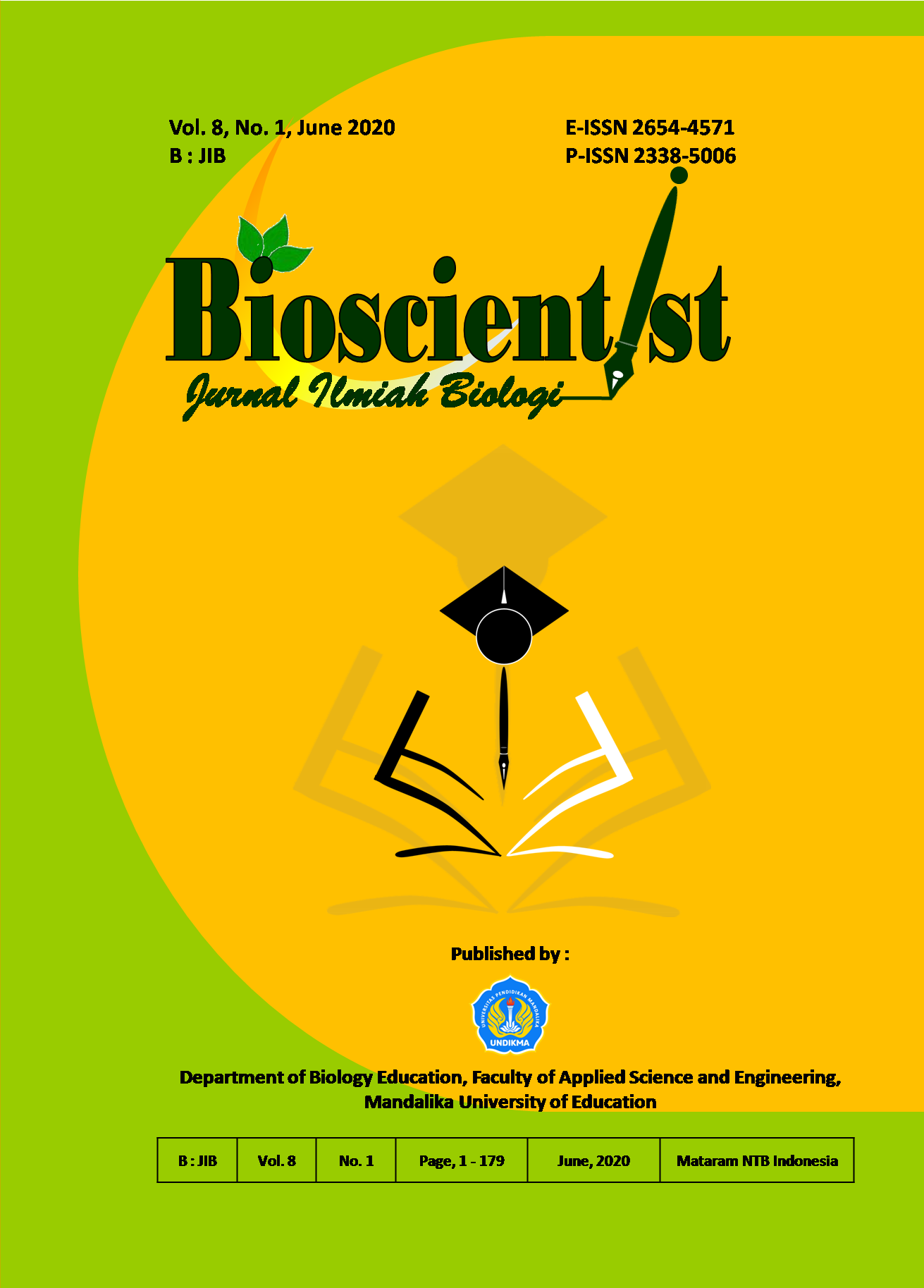KANDUNGAN LOGAM BERAT TIMBAL (Pb) PADA BERAGAM JENIS BIVALVIA DI KAWASAN PANTAI KABUPATEN BANGKALAN
DOI:
https://doi.org/10.33394/bioscientist.v8i1.2666Keywords:
Lead Heavy Metal (Pb), Bivalvia Type.Abstract
Bivalvia is one of the organisms that is able to accumulate heavy metal content in the body. Lead heavy metal (Pb) is a heavy metal that is toxic if the level exceeds the safe limit that has been set both on the body of an organism or in humans. The purpose of this study was to determine the various types of bivalves found in Bangkalan Coastal Madura Island, and to analyze the content of lead heavy metals (Pb) in bivalve bodies found in the region. This research is observational. Sampling was carried out by hand sorting, then identified the type of bivalves that were obtained and then the samples were taken to the laboratory for testing using the Atomic Absorption Spectrophotometer (AAS). The results of the study are known that, the types of bivalves found and identified in the Bangkalan Coastal area of Madura Island are Bamboo Scallops (Solen sp.), Blood Scallops (Anadara granosa), Sweet Scallops (Meretrix meretrix), and Stone Scallops (Placamen isabellina). Laboratory test results of lead heavy metal content (Pb), it is known that each clam accumulates lead heavy metal (Pb) with different amounts of concentration, wherein the heavy metal content of lead (Pb) in Bamboo / Lorry Shells (0.168-0.208 ppm) , Blood Shells (0.152-0.231 ppm), Sweet Shells (0.161-0.288), and Stone Shells (0.143-0.169 ppm), and it is known that the heavy metal content of lead (Pb) of the four bivalves is still below the threshold level of metal contamination according to Kep. Ditjen POM No. 03725/B/SK/VII/1989 which determines that the maximum limit of lead (Pb) heavy metal content in marine organisms is 2 ppm.References
Andrew, S. T. O. S., Siregar, Y. I., & Efriyeldi. (2014). Kandungan Logam Berat Pb, Cu, Zn pada Daging dan Cangkang Kerang Hijau (Perna viridis) di Perairan Tanjung Balai Asahan. Jurnal Online Mahasiswa : Fakultas Perikanan dan Ilmu Kelautan, 1(2), 1-11.
Anggraeny, Y. (2010). Analisis Kandungan Logam Berat Pb, Cd, dan Hg pada Kerang Darah (Anadara Granosa) di Perairan Bojonegara, Kecamatan Bojonegara, Kabupaten Serang. SSi Skripsi. Institut Pertanian Bogor.
Azhar, H., Widowati, I., & Suprijanto, J. (2012). Studi Kandungan Logam Berat Pb, Cu, Cd, Cr pada Kerang Simping (Amusium pleuronectes), Air dan Sedimen di Perairan Wedung, Demak serta Analisis Maximum Tolerable Intake pada Manusia. Journal of Marine Research, 1(2), 35-44.
Barik, F., Afianti, N., & Widyorini, N. (2014). Kajian Kandungan Natrium (Na) dan Logam Berat Timbal (Pb) pada Jaringan Lunak Kerang Darah (Anadara granosa) dari Perairan Tanjung Emas Semarang dan Perairan Wedung Demak. Management of Aquatic Resources Journal (MAQUARES), 3(1), 151-159.
Chairunisah, R. (2011). Karakteristik Asam Amino Daging Kerang Tahu (Meretrix meretrix), Kerang Salju (Pholas dactylus), dan Keong Macan (Babylonia spirata). SSi Skripsi. Institut Pertanian Bogor.
Indrawan, G. S., I Wayan, A., & Deny, S. Y. (2018). Kandungan Logam Berat Timbal (Pb) pada Kerang di Kawasan Perairan Serangan Bali. Jurnal Metamorfosa, V(2), 144-150.
Indriana, F. L., Anggoro, S., & Widowati, I. (2011). Studi Kandungan Logam Berat pada Beberapa Jenis Kekerangan dari Perairan Pantai di Kabupaten Flores Timur. Jurnal Perikanan (J. Fish. Sci.), XIII(1), 44-50.
Nurjanah, L. I., & Abdullah, A. (2011). Aktivitas Antioksidan dan Komponen Bioaktif Kerang Pisau (Solen sp.). Jurnal Ilmu Kelautan, 16(3), 119-124.
Wulandari, E., Herawati, E. Y., & Arfiati, D. (2012). Kandungan Logam Berat (Pb) pada Air Laut dan Tiram Saccostrea glomerata sebagai Bioindikator Kualitas Perairan Prigi, Trenggalek, Jawa Timur. Jurnal Penelitian Perikanan, 1(1), 10-14.
Yaqin, K., Liestiaty, F., & Fitriyani. (2018). Efek Ukuran Panjang Cangkang terhadap Indeks Kondisi, dan Kandungan Logam Timbal Kerang Hijau (Perna viridis). Jurnal Pengelolaan Perairan, 1(2), 27-40.













